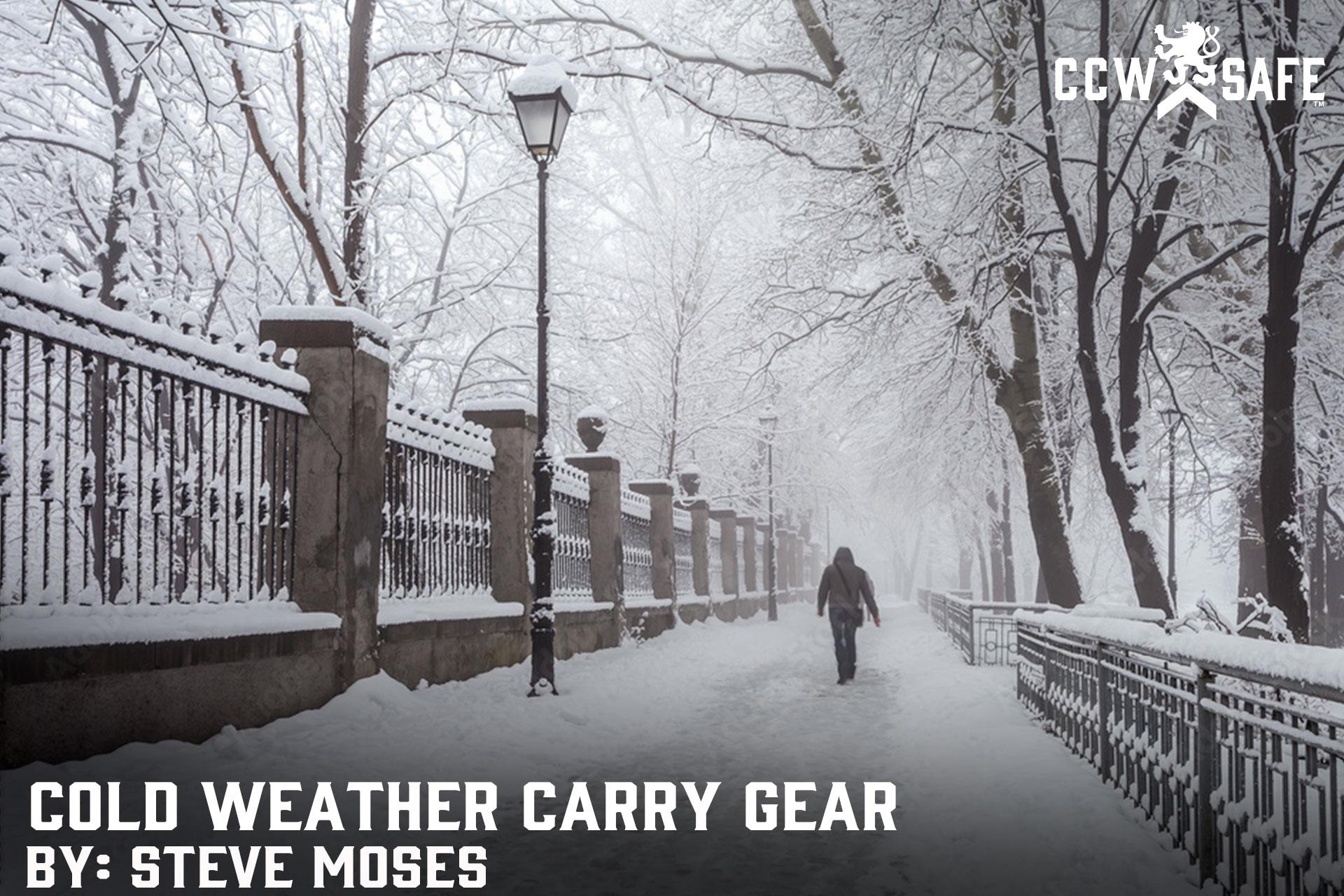
Posted on December 20, 2021
COLD WEATHER CARRY GEAR
I prefer carrying my concealed handgun on my waistline whether on my hip or in the appendix position. We know that that the ability to quickly draw and shoot accurately with a concealed handgun can be critically important if a criminal offender is armed with a handgun and that we are more likely to be injured and killed with hands, feet, and cutting instruments than with handguns. My ability to accomplish the above is greatly impeded during cold weather when I need to wear a fully zippered or buttoned coat in order to stay warm.
Most firearm instructors recommend that their students carry a compact or full-size semi-automatic handgun of at least 9mm caliber for self-defense if possible. I am the same way, although there is a place for smaller semi-automatic pistols and small revolvers for those who are unable to carry larger handguns for reasons of hand size, grip strength issues, or even the manner in which they must dress from day to day. My concern is about being armed during cold weather and how am I going to be able to access a handgun quickly enough to save my life if it is buried under a closed overcoat. No person intent on harming me is going to give me a break just because I am no longer able to draw my concealed handgun quickly.
Coat pocket carry is my preferred concealed carry method during cold weather in Texas. I realize that a lot of people think that Texas is warm weather country (and it is) but we experience our share of “Blue Northers” where the temperatures are below freezing, and the north wind shows no mercy for man or beast. The secret to safe coat pocket carry is a combination of a small user-friendly pistol or revolver and an intelligently designed pocket holster that stabilizes the handgun while carried in the pocket and fully covers the trigger-guard. Companies that make pocket holsters are Don Hulme, Galco, Sticky, and DeSantis. I currently use pocket holsters by Galco and DeSantis and have at one time owned holsters by the other two companies.
Obviously, any handgun capable of being carried in one of these holsters is going to be small. Handguns that strike me as good choices are going to be pistols such as the Glock 43 and Sig 365 and revolvers like the Colt Night Cobra, Ruger LCR, and Smith and Wesson J-frame enclosed hammer series such as 442 and 642. I am not a fan of exposed hammers for coat pocket carry, and some savvy concealed carriers simply bob the hammer on small revolvers that have exposed hammers. A protruding hammer is prone to snagging in the pocket when hurriedly drawn. However, a gunsmith can “bob” or “de-spur” (remove) that part of the hammer that protrudes in order to address that problem.
The downside to both small semi-automatic pistols and revolvers is that they are harder to shoot well and hold less ammunition than the larger compact and full-size semi-automatic pistols and revolvers. This is especially true when it comes to small revolvers, which is the reason that many knowledgeable revolver enthusiasts load their .38 caliber “snubbys” with lower velocity wadcutters. My preference is the Hornaday .38 Special 110 grain FTX round. One important consideration for me is the length of the trigger guard as well as the distance of the trigger from the front of the frame. I think there needs to be enough room to easily insert the trigger finger while wearing a lightly insulated glove.
Speaking of gloves, it may be necessary to wear insulated gloves that are not thick enough to interfere with quickly getting a grip on the handgun and properly positioning the trigger finger on the trigger. I recommend going to the range as soon as possible and practicing while wearing winter gloves. Some concealed carriers might be surprised to find that they are unable to shoot as well as when bare-handed. Much of this can be corrected by firmly gripping the buttstock of the handgun with both hands.
Another consideration is the size and location of the pockets on the winter coat. Pocket size can vary widely and so can the location of the opening. I have coats and jackets with openings on the top of the pockets as well as the side of the pockets. What this means to me is that I need to make sure there is harmony between the handgun, holster, gloves, and coat pockets.
Some thought should be given to managing encounters with persons of questionable intent. If I am around other people and my threat matrix sonar starts pinging, I remove myself from the area immediately. If that is not possible, my dominant hand goes into the pocket (after all, it is cold) and obtains a firing grip and my support hand remains in a position where I could block a sucker punch or throw a quick eye flick. While my dominant hand is in the holster, my trigger finger needs to be straight in compliance with Firearms Safety Rule Number Two (Always Keep Your Finger Off the Trigger Until Ready to Shoot).
Finally, concealed carriers should engage in dry practice and frequently practice drawing the handgun and getting two hands on it safely. It is all too easy to let the support hand get in front of the muzzle when drawing from unorthodox positions, and coat pocket carry definitely qualifies as unorthodox. The safest way to do this in my opinion is to place the palm of the support hand flat on the upper chest during the draw and then joining hands once the muzzle has definitely cleared the upper torso.
Concealed carriers who find coat pocket carry problematic might want to consider pants pocket carry. Biggest disadvantage to pants pocket carry that I see is the difficulty of accessing the handgun when seated.
One thing that I have not stressed is that cold weather carry does not mean that I leave the Glock 19 or 48 at home. It just means that I carry a second firearm as insurance in the event that the weather is cold on the day that one or more violent criminal actors make the decision that the next life they intend to take is mine.
 |
Steve MosesSteve Moses has been a defensive firearms trainer for over 26 years and is a licensed Texas Personal Protection Officer with 7 years of experience performing as shift lead on a church security detail for a D/FW area metro-church. Steve is a co-owner and Director of Training for Palisade Training Group, LLC based in Dallas, Texas. Moses is a retired deputy constable and spent over 10 years on a multi-precinct Special Response Team. He owns multiple instructor certifications, including Rangemaster Advanced Handgun Instructor and Defensive Shotgun Instructor, Red Zone Knife Defense Instructor and Adaptive Striking Foundations Instructor, Modern Samurai Project Red Dot Sight Instructor, and State of Texas Personal Protection Officer Instructor. Steve holds a BJJ Brown Belt in Relson Gracie Jiu Jitsu. He is a content contributor for CCW Safe and writes weekly articles on various subjects of interest to concealed carriers. Moses shoots competitively and holds an IDPA Expert rating. Steve is an annual presenter at the Rangemaster Tactical Conference. |